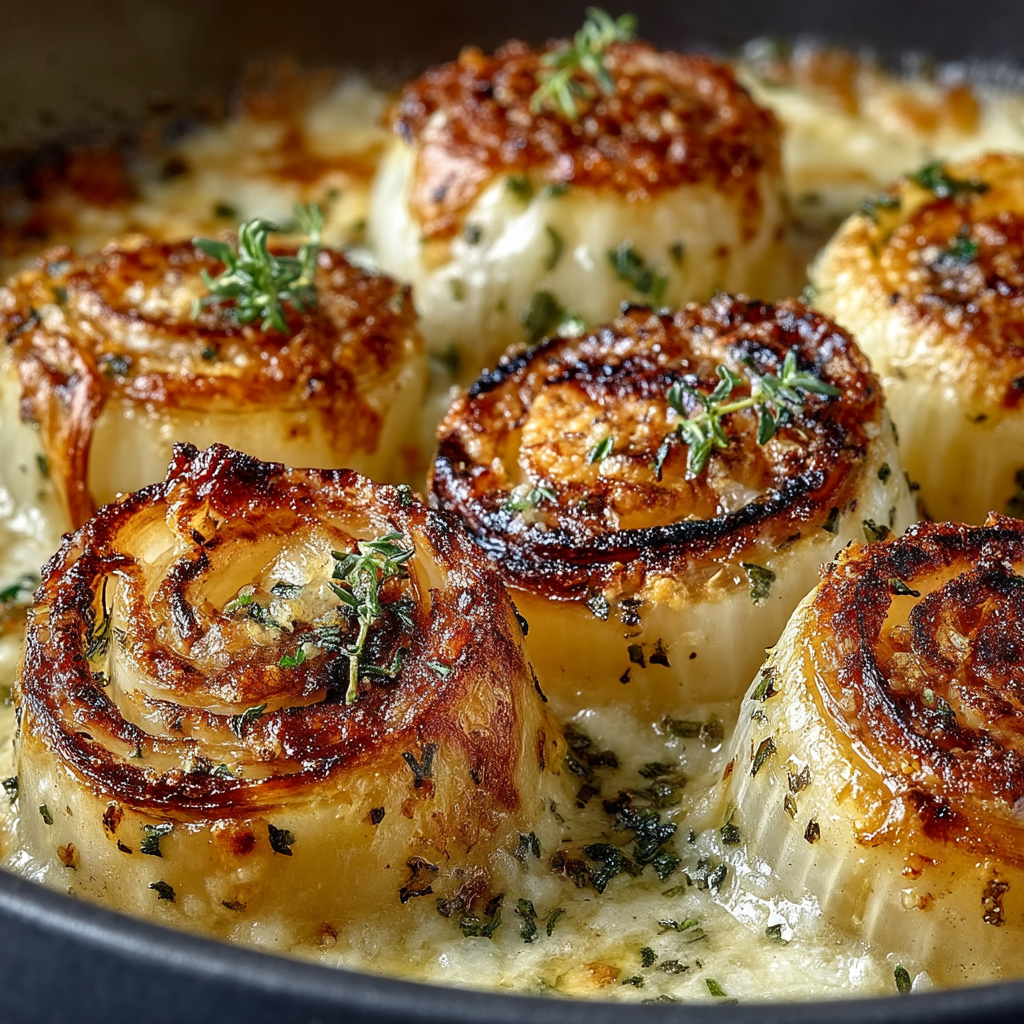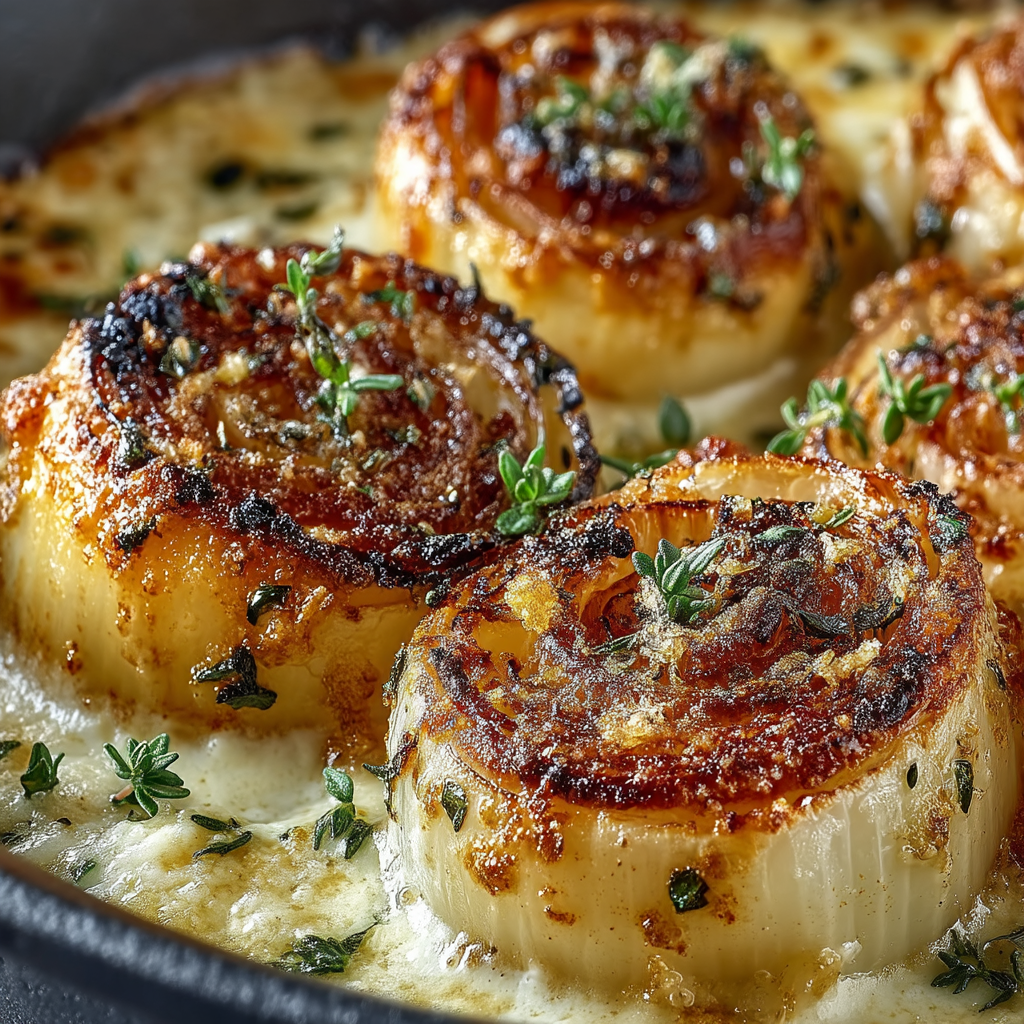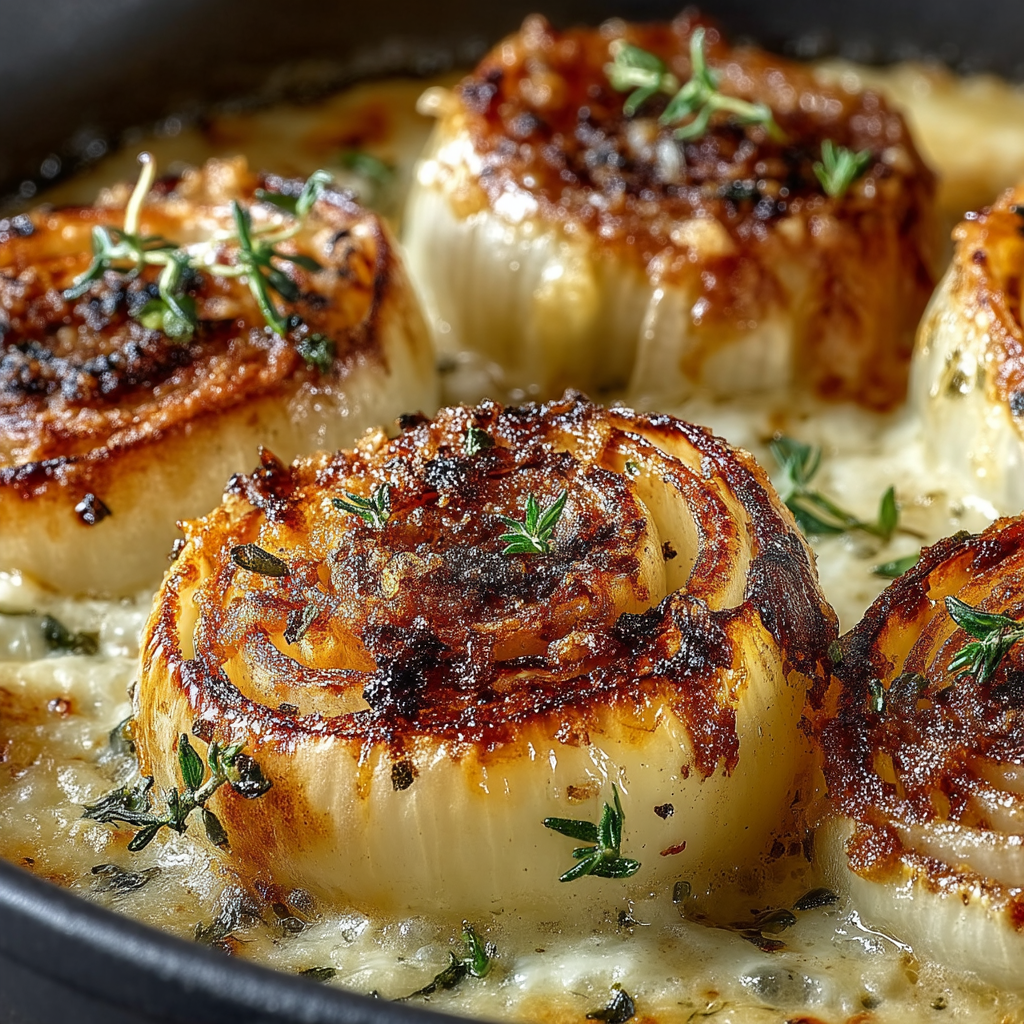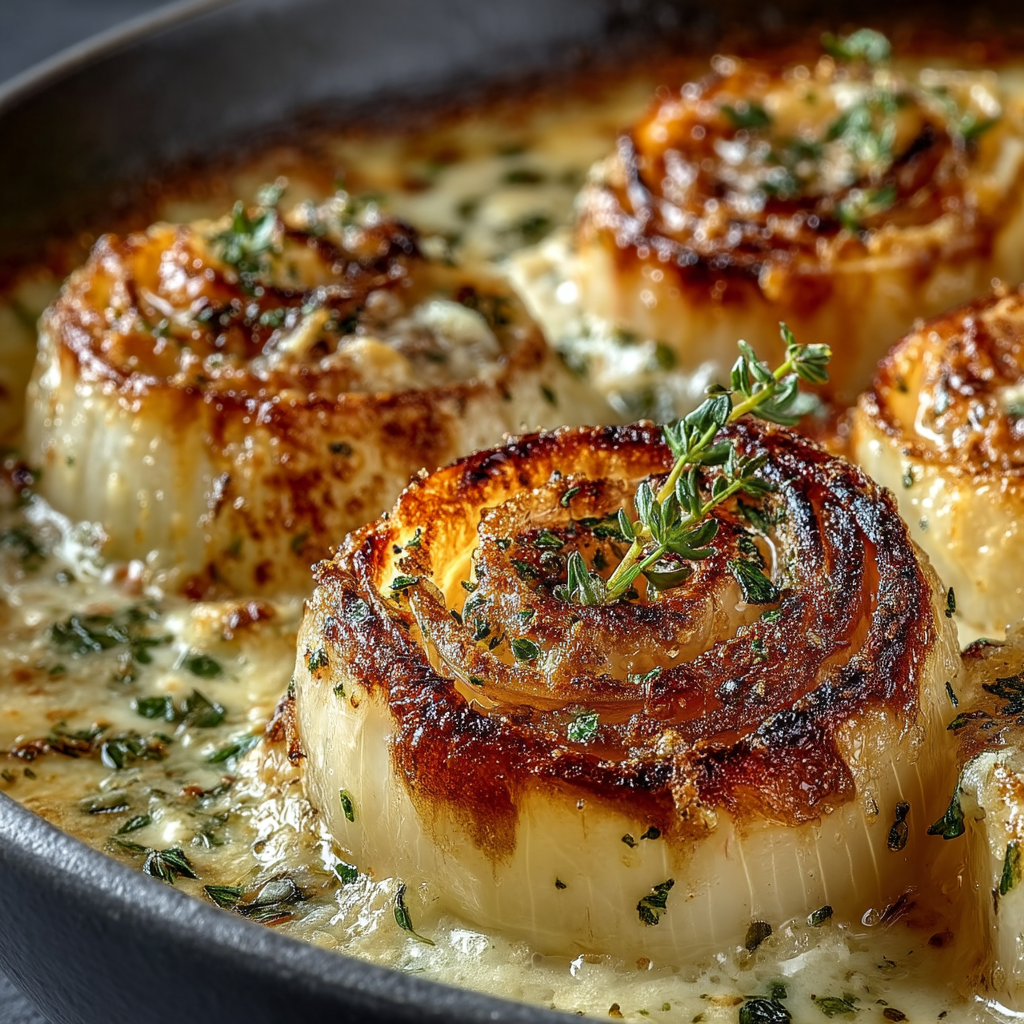Introduction to the Recipe
Asiago Creamy Baked Onions transform humble onions into an elegant, flavorful side dish that’s creamy, cheesy, and beautifully aromatic. This recipe highlights the natural sweetness of yellow onions, slow-baked to tender perfection and enriched with a luscious cream sauce infused with tangy Dijon mustard and the nutty, sharp flavor of Asiago cheese. The addition of fresh thyme brings a subtle herbaceous note, making this dish an irresistible accompaniment to roasted meats, poultry, or even a hearty vegetarian main.
What makes this recipe truly special is the balance between the silky cream and the savory Asiago cheese, which melts and browns just right, forming a delicious crust atop the tender onions. For those who love comforting baked dishes, this recipe offers a simple yet sophisticated way to elevate a basic vegetable. If you want to explore more cheesy baked vegetable recipes, check out this baked cheesy cauliflower gratin or learn tips on how to caramelize onions perfectly.
Whether you’re preparing a weeknight dinner or planning a holiday feast, Asiago Creamy Baked Onions offer a delightful combination of textures and flavors that are sure to impress your guests and delight your taste buds.
Basic Recipe: Ingredients and Instructions
Print
Asiago Creamy Baked Onions
Description
Delicious Asiago Creamy Baked Onions with tender onions, rich cream, and melted Asiago cheese—a perfect cheesy side dish for any meal.
Ingredients
-
4 large yellow onions, peeled and sliced into ¼-inch rounds
-
Olive oil, for drizzling
-
½ teaspoon fresh thyme, chopped
-
Salt, to taste
-
Black pepper, to taste
-
1 cup heavy cream
-
2 teaspoons Dijon mustard
-
½ cup Asiago cheese, grated
Instructions
-
Preheat your oven to 375°F (190°C). Lightly grease a baking dish with olive oil.
-
Arrange the onion slices in a single layer in the prepared dish, drizzling lightly with olive oil and seasoning with salt, pepper, and fresh thyme.
-
In a small bowl, whisk together the heavy cream and Dijon mustard until smooth. Pour this mixture evenly over the onions.
-
Sprinkle the grated Asiago cheese generously on top of the onions and cream.
-
Cover the dish loosely with foil and bake for 30 minutes. Remove the foil and bake for an additional 15–20 minutes, or until the onions are tender and the cheese is golden and bubbling.
-
Let cool slightly before serving.
Notes
Slice onions evenly to ensure uniform cooking.
Use freshly grated Asiago for the best melting and flavor.
Adjust salt and pepper to taste, considering the saltiness of Asiago.
Advanced Techniques
Selecting the best onions for baking
Yellow onions are preferred for baking due to their natural sweetness and ability to caramelize nicely. For a milder flavor, you can substitute with sweet onions or Vidalia, but avoid strong, pungent varieties that may overpower the dish.
Perfectly layering the onions
Layer onions in a single even layer for uniform cooking and cream absorption. Overlapping can result in uneven textures—some pieces may stay crunchy while others become mushy. A shallow baking dish helps achieve this.
Balancing creaminess and cheese melt
Whisking the Dijon mustard into the cream not only adds tang but also helps thicken the sauce during baking, preventing it from becoming too runny. Using freshly grated Asiago ensures it melts beautifully and forms a flavorful crust.
Incorporating fresh herbs
Fresh thyme is ideal for its subtle, earthy aroma that complements the onions and cheese. Add thyme early for mellow flavor or sprinkle fresh herbs just before serving for brightness.
Achieving a golden cheesy crust
Uncovering the dish for the last 15–20 minutes allows the Asiago to brown perfectly without burning. If desired, broil for 1–2 minutes at the end for extra crispiness—watch carefully to avoid over-browning.
See more advanced recipes at cookingwhite.com

Storage, Shelf Life, and Maintenance Tips
Storing leftovers in the refrigerator
Store cooled Asiago Creamy Baked Onions in an airtight container in the fridge for up to 3 days. Reheat gently in the oven or microwave before serving to retain creaminess and flavor.
Freezing baked onions
While cream-based dishes can be tricky to freeze, you can freeze the onions without cheese or cream for up to 2 months. Reheat gently and add fresh cream and cheese before serving.
Reheating without drying out
To avoid drying, reheat covered in the oven at 325°F (160°C) or use microwave at medium power, stirring gently halfway through. Adding a splash of cream before reheating helps maintain moisture.
Maintaining the creamy texture
Avoid overheating as high heat can cause cream to separate. Slow reheating and gentle stirring help preserve the luscious texture.
Tips for making ahead and serving
Prepare onions a day ahead and bake just before serving to save time. Freshen up with a sprinkle of additional cheese or herbs after reheating.

Dietary Adaptations and Substitutions
Using dairy-free cream alternatives
Swap heavy cream for coconut cream or cashew cream for a dairy-free, vegan option. Be mindful that these alternatives may alter the flavor slightly but still provide rich creaminess.
Substituting Asiago cheese
Parmesan or Pecorino Romano can be used instead of Asiago for a similar nutty, salty flavor. For a milder option, try Gruyère or aged cheddar.
Low-fat version
Use half-and-half or whole milk mixed with a bit of flour to thicken as a lighter substitute for heavy cream, though this will reduce richness.
Herb variations
Try rosemary, sage, or tarragon in place of thyme to customize the flavor profile to your liking.
Gluten-free preparation
This recipe is naturally gluten-free; just ensure any additional seasonings or cheese used are labeled gluten-free.

FAQs About the Recipe
Can I use red or white onions instead of yellow?
Yes, but yellow onions offer the best balance of sweetness and texture. Red onions may add color but can be more pungent, while white onions are sharper and less sweet.
Why do the onions need to be sliced ¼-inch thick?
Uniform ¼-inch slices ensure even cooking and prevent some slices from overcooking while others remain raw. Thicker slices hold their shape better during baking.
Can I prepare this dish ahead of time?
Absolutely. Assemble the dish up to a day ahead and refrigerate. Bake just before serving for the freshest results.
How do I know when the onions are fully cooked?
Onions should be tender and translucent when pierced with a fork. The cheese on top should be bubbling and golden brown.
Is Dijon mustard necessary in the recipe?
Dijon mustard adds subtle tang and depth to the cream sauce. If you don’t have it, you can omit or substitute with a small amount of whole grain mustard or dry mustard powder.

Conclusion & Final Thoughts
Asiago Creamy Baked Onions bring a touch of elegance and comfort to any meal with their tender texture, creamy sauce, and rich cheesy topping. This recipe is simple yet sophisticated, turning everyday onions into a show-stopping side dish. It’s ideal for holiday dinners, weeknight meals, or any occasion where you want to impress with minimal effort.
The balance of sweet onions, nutty Asiago cheese, tangy Dijon mustard, and fragrant thyme creates layers of flavor that meld beautifully during baking. This dish pairs wonderfully with roasted meats, grilled poultry, or even alongside a fresh salad for a lighter option. Its ease of preparation and flexible ingredient list make it a perfect addition to your cooking repertoire.
Whether you’re a seasoned cook or new to baking vegetables, Asiago Creamy Baked Onions offer a foolproof way to add creamy, cheesy comfort to your table. Their savory richness and satisfying texture make them a guaranteed crowd-pleaser. Next time you want to elevate your side dishes, give this recipe a try—you won’t be disappointed.

